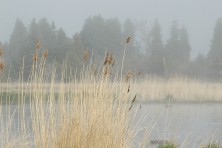Using Technology to Fight Phragmites
- Share
- Tweet
- Pin
- Share
We pass them every day, clumped together along wetlands, lakeshores and roadsides with their heads bobbing in the wind. We see them, but maybe we forget that Phragmites australis – the common reed – is an invasive species, and is considered a noxious weed by the U.S. Department of Agriculture because Phragmites rapidly spreads underground via rhizomes that can choke out native plants and create a monoculture.

Amanda Pyke uses a Panasonic Toughbook to map a roadside Phragmites patch in Baileys Harbor during a recent search for the invasive perennial grass.
Once you do notice them, you realize they are everywhere.
But there are watchful eyes taking note of Phragmites stands in the hope of one day eradicating the invasive grass.
“We’ve been making grid-like patterns throughout the county,” said Amanda Pyke, a conservation assistant with The Nature Conservancy who has been conducting the Phragmites mapping effort with the help of volunteers with the Door Stewardship Alliance.
Recently the mapping effort found her driving through Fish Creek, Egg Harbor and Baileys Harbor, looking for Phragmites stands and taking note of other invasives, marking locations via GPS (global positioning system) and GIS (geographic information system) on a Panasonic Toughbook.
On the Baileys Harbor leg of the search, she was accompanied by gung-ho volunteer Tom Mabbott. They began their search on Old Lime Kiln Road north of Baileys Harbor and worked their way south driving down the side roads. When they spot a Phragmites stand, Pyke is able to map each stand on the electronic tablet.
“We’re looking to fill in gaps we haven’t mapped yet,” said Pyke.

Phragmites on the side of the road in Baileys Harbor.
“The mapping project is very important,” said Conservationist Greg Coulthurst of the Door County Soil and Water Dept. “No. 1, it gives us a very accurate account of what’s out there. With that, we can start budgeting for next fall, so we like to get a lot of this done now. Contractors really appreciate the GPS mapping. It’s easier to bid on because they know what they’re getting into.”
Door County’s Phragmites control program began about six years ago with some small grants.
“At first we were doing first-come, first-served, kind of a hopscotch method. Some got treated and their next-door neighbor did not,” Coulthurst said. “It didn’t take long to figure out doing it in that fashion was not very productive.”
Detroit Island became the first large-scale project, which was made possible by a grant from the Lakeshore Natural Resource Partnership.
“Because of the price, we were able to do Washington Island as well, and the Washington Island landowners came though with money to help. That’s when we started doing the GPS inventory, to try to get a more accurate idea of what’s out there,” Coulthurst said.

Patches of the invasive Japanese Barberry were found all along Bluff Road in Baileys Harbor.
Coulthurst said two years of treatment are necessary.
“Even though we were getting 90 percent kill the first year, it’s very important to get anything that’s remaining. That has helped to keep things knocked down, but that doesn’t mean it’s gone forever. We can knock it down and get it under control, but somebody needs to do the maintenance.”
Coulthurst said it would be great if other municipalities followed the lead of Jacksonport and Nasewaupee, which have added Phragmites and wild parsnip to their noxious weed ordinance.
“If we’re talking sustainability, how we’re going to sustain this effort, it’s got to start focusing at local levels, whether it’s associations or towns or villages, something’s got to be done on a more local effort.”

